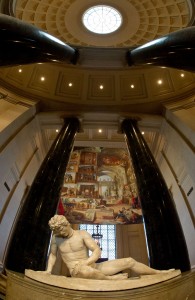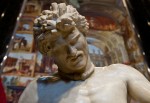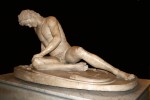 One of the most famous masterpieces of Hellenistic sculpture, The Dying Gaul, has taken its first trip abroad since 1816 when it returned to Rome from 20 years’ exile in Paris, a sentence suffered by so much of Italy’s historical patrimony at Napoleon’s grasping hand. It is on view through March 16th, 2014, at the National Gallery of Art in Washington, D.C., star of its own exhibition, The Dying Gaul: An Ancient Roman Masterpiece from the Capitoline Museum, Rome. The sculpture has been beautifully situated in a rotunda modeled after the Pantheon in Rome, underneath a banner with a detail of Giovanni Paolo Panini’s Ancient Rome, a capriccio, aka a fantasy scene in which all of ancient Rome’s greatest art and architecture is on display in a single gallery with The Dying Gaul in the left foreground.
One of the most famous masterpieces of Hellenistic sculpture, The Dying Gaul, has taken its first trip abroad since 1816 when it returned to Rome from 20 years’ exile in Paris, a sentence suffered by so much of Italy’s historical patrimony at Napoleon’s grasping hand. It is on view through March 16th, 2014, at the National Gallery of Art in Washington, D.C., star of its own exhibition, The Dying Gaul: An Ancient Roman Masterpiece from the Capitoline Museum, Rome. The sculpture has been beautifully situated in a rotunda modeled after the Pantheon in Rome, underneath a banner with a detail of Giovanni Paolo Panini’s Ancient Rome, a capriccio, aka a fantasy scene in which all of ancient Rome’s greatest art and architecture is on display in a single gallery with The Dying Gaul in the left foreground.
This exhibition is the only time the masterpiece has ever been to the United States and it won’t be traveling to any other museums. If you want to see this incredible portrait of mortally wounded strength and nobility, you have three months to get to D.C.
 The Dying Gaul is a 1st or 2nd century A.D. marble copy of what was probably a Hellenistic bronze original made between 230 B.C. and 220 B.C. to celebrate the victory of King Attalus I of Pergamon over the Celtic tribes of Galatia, an area of central Anatolia, now in Turkey. Gauls had immigrated there from Thrace after their invasion of the Balkans in 279 B.C. They had a reputation as fierce warriors and often sold their soldiering services to the squabbling factions of Asia Minor. Attalus’ defeat of them was considered a great victory because of their reputed strength in battle and the theme of defeated Gauls, stoic and powerful to the end, became a popular motif in Hellenistic art for several decades.
The Dying Gaul is a 1st or 2nd century A.D. marble copy of what was probably a Hellenistic bronze original made between 230 B.C. and 220 B.C. to celebrate the victory of King Attalus I of Pergamon over the Celtic tribes of Galatia, an area of central Anatolia, now in Turkey. Gauls had immigrated there from Thrace after their invasion of the Balkans in 279 B.C. They had a reputation as fierce warriors and often sold their soldiering services to the squabbling factions of Asia Minor. Attalus’ defeat of them was considered a great victory because of their reputed strength in battle and the theme of defeated Gauls, stoic and powerful to the end, became a popular motif in Hellenistic art for several decades.
Pliny mentions in his Natural History that Epigonus, court sculptor to the Attalid kings of Pergamon, created a group of bronze sculptures of dying Gauls to decorate the terrace of the Temple of Athena Nikephoros in honor of Attalus’ victory. The original Dying Gaul is thought to have been one of them, as is the original of Gaul Killing Himself and His Wife. The Roman copies of both of those pieces were documented for the first time on the November 2nd, 1623, inventory of the Ludovisi collection. The estate of the powerful papal Ludovisi family corresponded with the famed Gardens of Sallust, a property outside of Rome that had once belonged to Julius Caesar and was later purchased by the Roman historian Sallust who made it into a lush garden so beautiful it was confiscated by Roman emperors and maintained for centuries as a public garden.
 When the Ludovisi family began building their complex on the grounds in the early 17th century, they dug up Roman sculptures in impressive quantities and even more impressive quality. (See this entry for more about the Ludovisi collection and its painful dispersion in the 19th century.) The Dying Gaul, then thought to be a dying gladiator, was recognized as a masterpiece right away. Artist Ippolito Buzzi restored it with a comparatively light hand, more modest and respectful of the original than many of the other 17th and 18th century restorations. On March 29th, 1737, Pope Clement XII bought The Dying Gaul for 6,000 scudi, a huge amount at the time, and installed it in the Capitoline Museums.
When the Ludovisi family began building their complex on the grounds in the early 17th century, they dug up Roman sculptures in impressive quantities and even more impressive quality. (See this entry for more about the Ludovisi collection and its painful dispersion in the 19th century.) The Dying Gaul, then thought to be a dying gladiator, was recognized as a masterpiece right away. Artist Ippolito Buzzi restored it with a comparatively light hand, more modest and respectful of the original than many of the other 17th and 18th century restorations. On March 29th, 1737, Pope Clement XII bought The Dying Gaul for 6,000 scudi, a huge amount at the time, and installed it in the Capitoline Museums.
There it remained for 60 years until Napoleon stepped into the picture. By the terms of the Treaty of Tolentino, the 1797 peace treaty between Directory France and the Papal States, all the art French troops had looted became official French property. the treaty also gave French officials the untrammeled right to literally walk into any building in the territory and pick whatever they wanted to send back to France. Napoleon had experts on the scene to ensure Italy’s greatest treasures would become France’s for the duration of his rule. After Napoleon’s final defeat, the Tolentino plunder was returned to Italy.
 The timing was perfect for The Dying Gaul to seduce the flocks of Romantic artists and Grand Tourists. Lord Byron wrote about him in Childe Harold’s Pilgrimage (Canto IV, Stanza CXL) just two years after the statue’s return to the Capitoline Museum.
The timing was perfect for The Dying Gaul to seduce the flocks of Romantic artists and Grand Tourists. Lord Byron wrote about him in Childe Harold’s Pilgrimage (Canto IV, Stanza CXL) just two years after the statue’s return to the Capitoline Museum.
I see before me the Gladiator lie:
He leans upon his hand — his manly brow
Consents to death, but conquers agony,
And his droop’d head sinks gradually low —
And through his side the last drops, ebbing slow
From the red gash, fall heavy, one by one,
Like the first of a thunder-shower; and now
The arena swims around him — he is gone,
Ere ceased the inhuman shout which hail’d the wretch who won.
Many literary luminaries followed in his wake. Mark Twain gave The Dying Gaul a rare unsarcastic positive review in Innocents Abroad. Nathaniel Hawthorne’s The Marble Faun opens on the sculpture. Henry James called it the “lion of the collection” in The Portrait of a Lady. The Gaul even gets a passing reference in Charles Dickens’ Great Expectations (bottom of the page here).
Because one of the greatest works of ancient art surviving doesn’t budge unless compelled by terms of sale or at bayonet-point, copies of The Dying Gaul are in museums, institutions of higher learning and private collections all over the world. Smugglerius is my personal favorite. Until his debut at the NGA last Thursday, that was as close as anybody outside of Italy was going to get to seeing him.
I observed with wonder and curiosity that the Dying Gaul’s left hand is that of female or at least it exhibits the a prime sexual dimorphic characteristic of having an index finger longer than the ring finger ! As to the significance of this discovery I have not a clue. Perhaps it was observer long ago and has been throughly explored and exhausted. With my limited resources and knowledge I could come up with nothing on the subject. I am after all only a MFA in sculpture( see The West Virginia Veterans Memorial) not a PHD of Art History.
So the gauntlet is down—Enjoy and prove to me that I am but a simple Appalachian Rustic. Thank you in advance for your contributions.
Note: the work of John Manning might be informative. PJM.
:hattip: